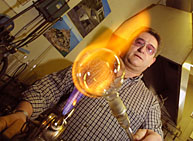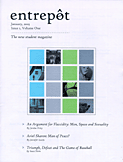Kaleidoscope
Georges Kopp: Hottest job on campus
 Photo: Owen Egan
Photo: Owen Egan |
|
In the bowels of the Otto Mass building there is a workshop where an ancient craft is practiced. Wielding flame and water, diamond and steel, a solitary craftsman creates fantastical structures of unique beauty and complexity -- spheres within spheres, tubes and pipes snaking in complicated patterns, intricate structures that look like they were ripped from the imagination of J.R.R. Tolkien.
They are the work of Georges Kopp, McGill's glassblower. Though he is a master craftsman in an art whose origins are lost in the mists of antiquity, his work is integral to the cutting-edge research and teaching of the university.
Kopp's work usually starts when a student or professor approaches him with an idea for a device they need for an experiment. Kopp will sit down with them to work out what they need to accomplish, and what it is possible for him to create.
"It's a relationship -- I sometimes spend hours making drawings with students that seem feasible," he said.
Sometimes it's longer than hours. One particularly elaborate contraption of tubes, flasks and distillation pipes in an upstairs lab took him about a year to assemble.
Sounds complicated, but the basics of Kopp's work remain the same as they have for centuries. An oven and a giant lathe dominate his small workshop. Gas torches hiss in their stands on his worktable. Kopp himself is a craftsman of the old school. He is from the Alsace region of France, where he was trained in scientific glassblowing.
"I'm from a family of glassblowers, all my ancestors were glassblowers for generations," he said.
To the untrained eye, watching Kopp work is a little like magic. Taking a tube of Pyrex glass, he dons a pair of what look like sunglasses; ("All the early glassblowers used to get cataracts from the light") and turns on his torch. As he carefully rotates the glass in the flame to ensure it heats evenly, the Pyrex begins to glow, and then slowly grows thinner and longer as he gently elongates the piece. As a demonstration, he separates it into two, seals the end of one and then gently blows into its other end. It turns into a bubble, the glass stretched so thin he is eventually able to break it with a gentle tap; the pieces are like cellophane.
To cut a tube is even more like magic. Fixing one end of a large tube in his lathe, he applies a flame while it rotates. He uses a diamond tip pen to gently score the glass, and then applies one tiny drop of water to the glass. It separates in a clean cut.
"It's called thermal shock," explained Kopp, adding that the cool water on the hot glass is enough to cause the glass to separate along his cut.
"Sometimes even the cooler air is enough to do it."
Working with such high heat -- the gas torches burn at 1,000 degrees Celsius -- makes glassblowing a dangerous business. The delicate touch required to manipulate the glass means Kopp can't work in gloves. He's burned himself countless times ("I set my shirt on fire once -- I had to roll on the floor to put it out") and he can still occasionally feel a shard of glass that is embedded near his elbow from an accident years ago.
Kopp is something of a rarity in North America -- most glassblowers this side of the Atlantic are either self-trained or learn their craft informally. Few have Kopp's combination of formal training and decades of experience. He recently won an award for best Technical Paper at the 2002 American Scientific Glassblower Society. His winning paper was "Tools: The Extra Hands of the Glassblower." It's an appropriate topic for him.
"My advantage and my disadvantage is that I'm working alone. I don't have the help of another person, but I also can come up with my own way of doing things," he said.
Ever an innovator, Kopp has invented a variety of clips, props and other gadgets that he can use to help him do his job more easily. The ideas for them often occur to him while he doodles on his lunch hour.
"One time I designed a device for making flanges during a concert. I doodled on the back of the program," he said.
With the sheer variety and number of projects Kopp works on -- in addition to the creative glassblowing projects he makes in his home workshop -- one might think it would be hard to pick a favourite. Not at all. Kopp produces a photo of a snail with two glass hats over its sensory stalks. It was a biology department project to measure snail responsiveness to pheromones. He also takes great pride in an intricate piece he keeps in his lab. It's a tube with electrodes at each end. Within, a paddlewheel rotates along a track made of thin glass. It was built to measure the physical force of an electrical current. Surprisingly, Kopp didn't make it -- it's fifty years old.
"I wish I had made it. I keep it because it is a masterpiece."
 |
||||
|
For me summer is hope and fulfilment....Just like the squirrels put their nuts away for the winter, we kind of do the same thing psychologically with the summer. |
||||
Students have their way with words
 |
|
The word magazine derives from an old French word meaning "warehouse." The modern French word for warehouse is entrepôt. Entrepôt, is therefore a magazine. Not just a silly syllogism, it's a literary candy store of essays, articles, fiction and poetry by undergraduate students from across the country, and it was born at McGill.
They have high ideals, explains Neil Rogachevsky, who co-founded the magazine last year with Benji Leszcz, a Dalhousie student at McGill on exchange.
"We decided that there was a void in publications available to students. Student newspapers do a good job at what they do, but they focus very much on micro-issues. We felt there was room and desire for a publication that was more outward looking," explained Rogachevsky.
"We did buy into the cliché that we've entered a 'period of new seriousness' that demands examination in a broad way."
There was definitely room for it. Mining their contacts the duo attracted contributors literally from coast to coast. Rogachevsky said that they envisioned a publication that would take Harper's and the Atlantic Monthly as models. As a result, the first issue of Entrepôt, published in January, is a grab bag of articles on a variety of topics such as male sexuality, Middle East politics and the political significance of professional wrestling.
The editorial duo recruited collaborators and contributors from across the country. Danielle Metcalfe-Chenail, co-president of the McGill Writer's Circle, contributed a thoughtful essay on the evolution of the modern university. She saw Entrepôt as an opportunity to do some writing beyond the academic papers required by her history/Canadian studies program.
"I think Entrepôt is trying to bridge the gap between academic and creative writing," she said.
"It was a challenge for me -- I'm always looking to expand my horizons. I figured if I was telling other people to write in the Writers' Circle I should step up to the plate myself."
With an initial print run of only 5,000 copies the magazine was not able to attract any advertisers. Money for the first issue -- which can be picked up for free on campus -- came from a variety of sources, including three different student unions and the principal's office of McGill and the president's office of Dalhousie.
"Both of us had been at the creative end of things, but as far as the business end of things went we had no idea what to do. Eventually we crafted a funding strategy where we would pitch our project to various academic institutions first. The element we were going for was that it was a unique opportunity for inter-university collaboration."
Rogachevsky said that they hope to make the magazine a quarterly. The next issue should be out in March.
 |
||||
|
No one doubts that food ingestion can influence mood and behavior, but the mechanisms by which this happens are not fully understood. Perhaps the most dramatic effect [of food on mood] is in an infant. The transformation of an infant from crying and irritability to postprandial contentment and responsiveness that delights its parents can be dramatic. If a drug had a similar effect, it would be considered powerful. |
||||

